Coronavirus infection rates have plummeted by more than two thirds since January, new figures show in proof that lockdown is working even against the fast-spreading Kent variant of the virus.
The country’s largest surveillance testing study yesterday found just one in 196 people in England were infected with the virus during the first half of February, down from one in 64 the last time around, in January.
Results from the REACT study, led by Imperial College London and commissioned by the Government, revealed 0.51 per cent of the population had the virus between February 4 and February 13, down from 1.57 per cent.
The testing of 85,400 people during this time revealed the R rate – the average number of those infected by each person with the virus – was estimated to be 0.7, meaning the epidemic is shrinking. The figures revealed a ‘marked drop’ in prevalence compared to last month, and a ‘reassuring level of decline’.
The positive news will no doubt pile more pressure on Boris Johnson – who was last night facing a growing clamour for the speedier lifting of lockdown.
Amid fears that Covid restrictions might last for months, business chiefs and MPs demanded an accelerated timeframe to save firms from collapse. Also warning of the social cost of lockdown, they cited the vaccine roll-out success and significant falls in deaths and infections.
The vaccine rollout has helped slash the number of deaths and infections, but the PM is being regularly reminded of the social cost of lockdown, amid fears firms unable to open under current restrictions will soon collapse.
The Prime Minister appeared to confirm a cautious timetable yesterday, saying he would take a ‘prudent’ approach and suggesting that pubs and restaurants would be among the last places to reopen.
The data shows that prevalence fell across all age groups, but research now suggests the virus is now spreading the most among primary school children and young people. Experts warn that reopening schools would need to be done ‘carefully’ in light of the study data, which shows Covid is most prevalent among five- to twelve-year-olds and those aged 18 to 24.
The relatively high number of children still attending school could be behind the high frequency in young people, it was suggested, the Guardian reports.
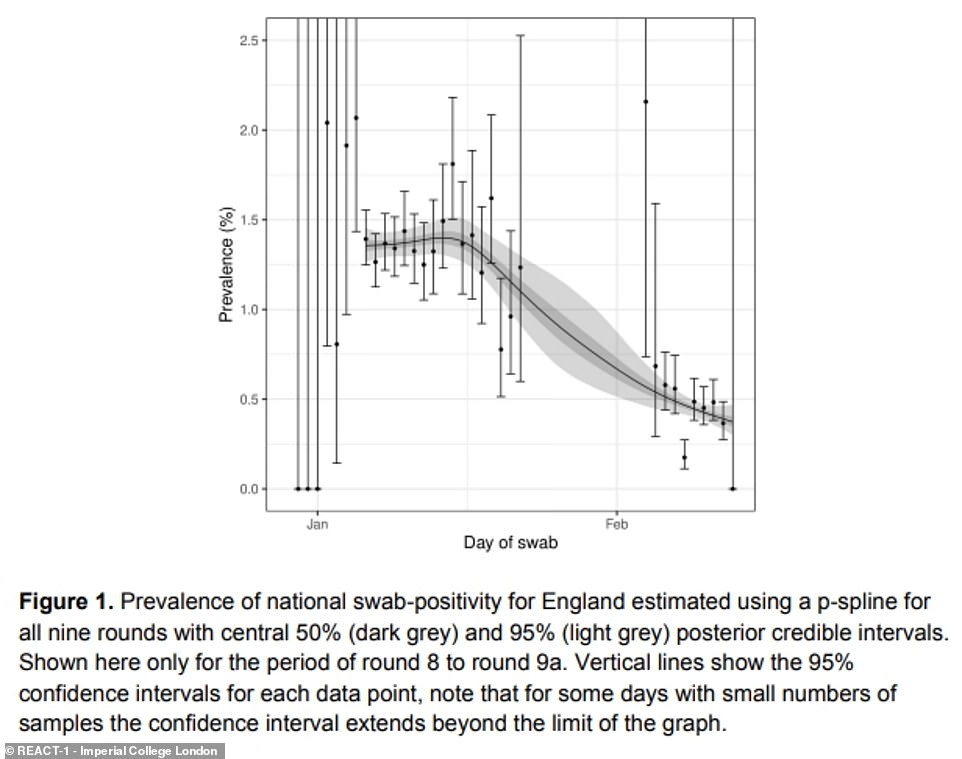
The country’s largest surveillance testing study has found just one in 196 people in England were infected with the virus during the first half of February, down from one in 64 the last time around, in January – the prevalence fell from 1.36 per cent to 0.44 per cent
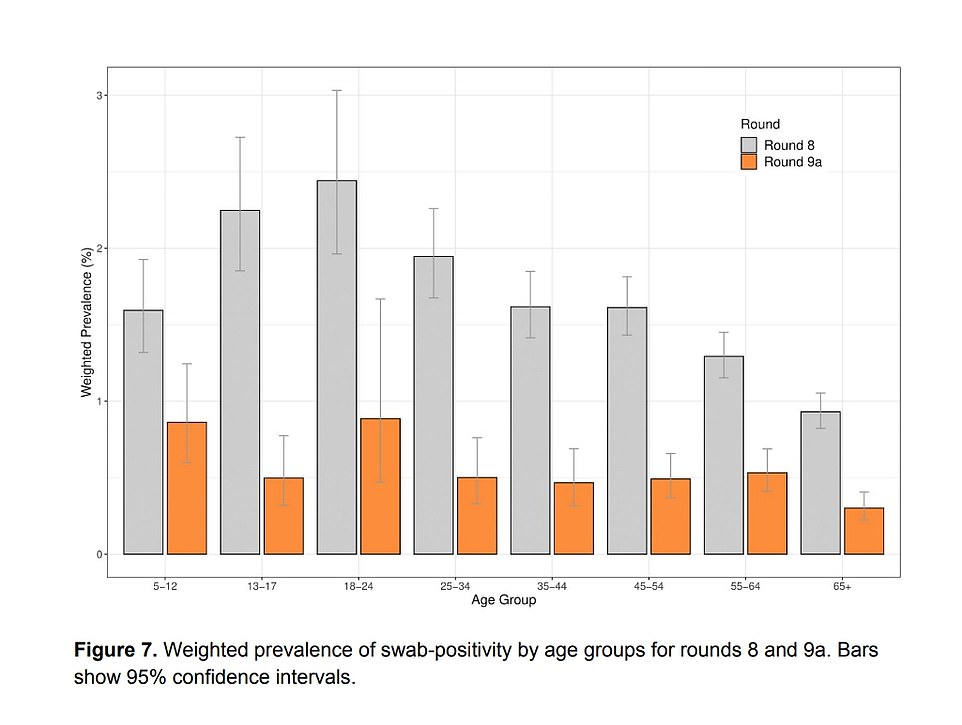
The data shows that prevalence fell across all age groups, but research now suggests the virus is now spreading the most among primary school children and young people. Experts warn that reopening schools would need to be done ‘carefully’ in light of the study data, which shows Covid is most prevalent among five- to twelve-year-olds and those aged 18 to 24
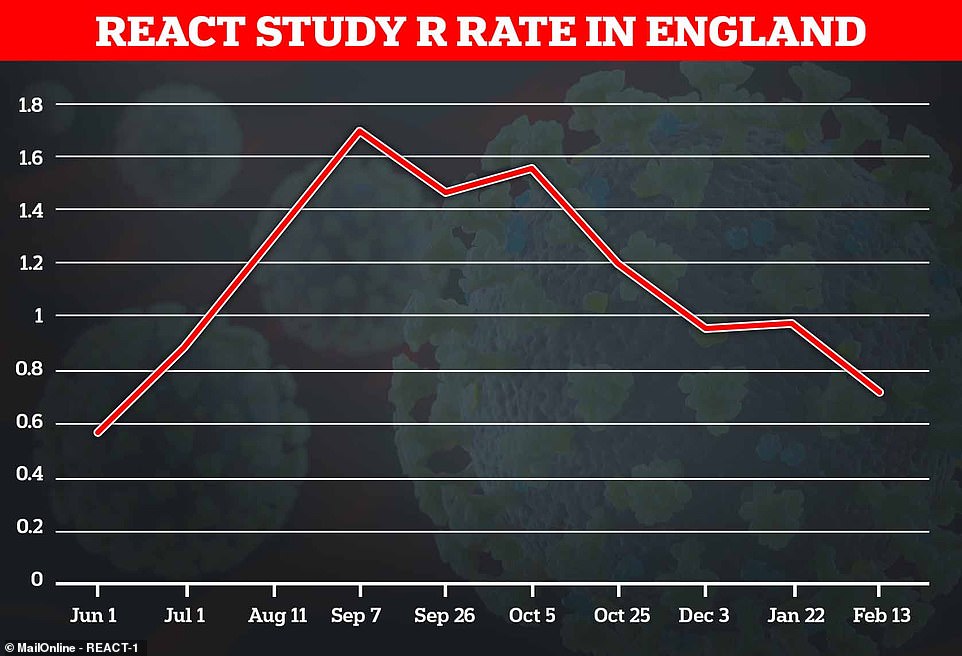
The R rate of the virus – the number of people infected by each person with coronavirus – is now at its lowest point in more than six months, the Imperial College estimates suggest, at 0.72, meaning the outbreak is shrinking
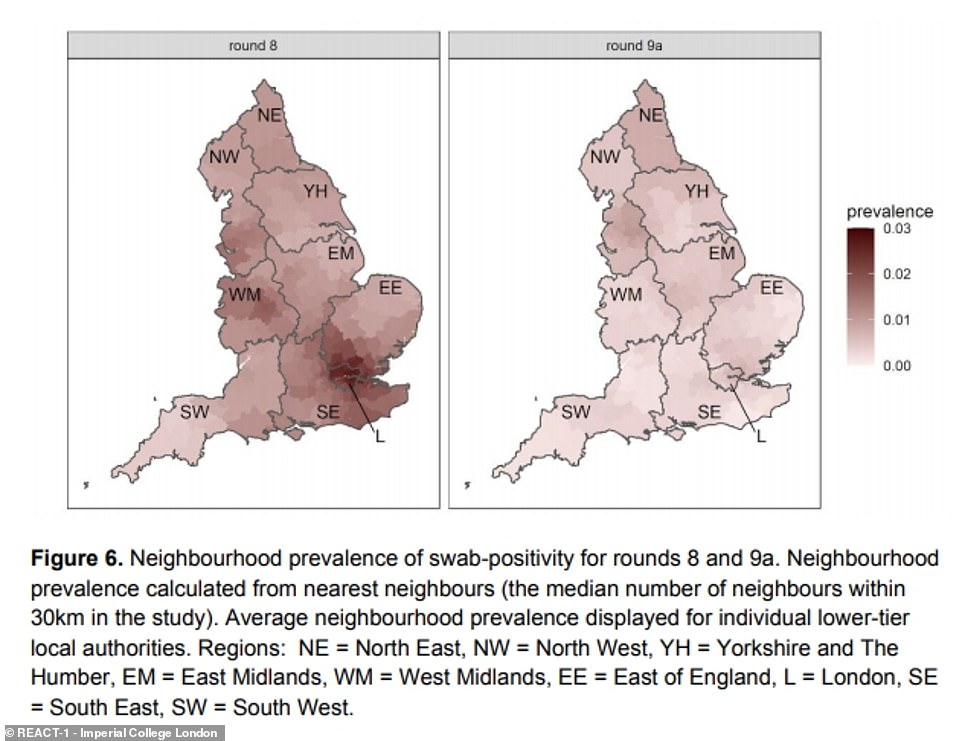
The proportion of people infected with the virus, also known as the prevalence, has come down in all regions of England in the past six weeks, the study found. Darker areas have more people testing positive for coronavirus – the map on the left represents mid-January, and the map on the right mid-February
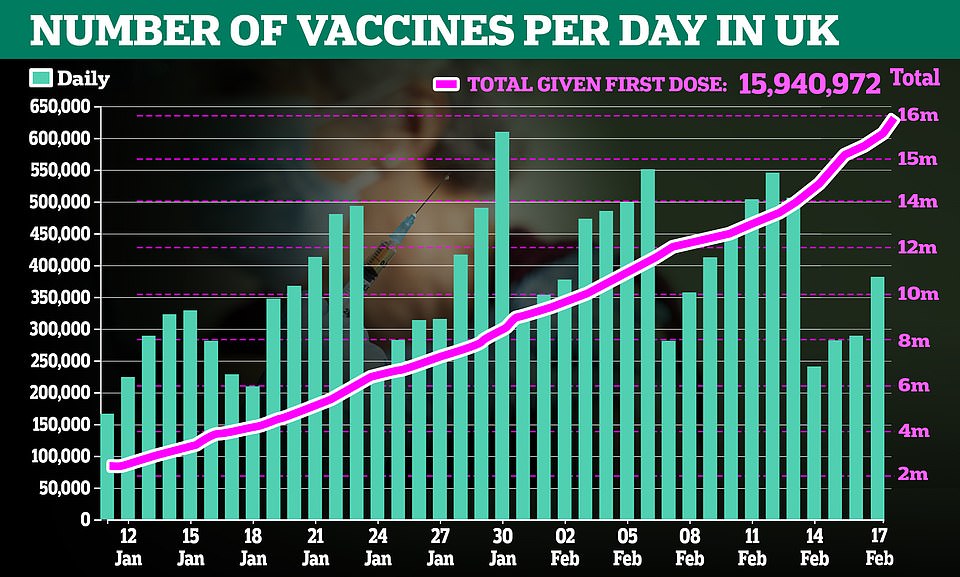
Covid cases are now spreading fastest among primary school children and young adults
Coronavirus is now spreading the most among primary school children and young people, according to the results of the surveillance study.
The data — from Imperial College London’s REACT study — showed that prevalence fell across all age groups.
But Covid is now most prevalent among five- to twelve-year-olds and those aged 18 to 24, with around 0.85 per cent of everyone swabbed in those age groups testing positive.
For comparison, the rate was around 0.3 per cent for the over-65s.
Experts warn that reopening schools would need to be done ‘carefully’ in light of the study data.
The relatively high number of children still attending school could be behind the high frequency in young people, it was suggested, the Guardian reports.
Advertisement
In other developments:
738 deaths were reported yesterday, down from 1,001 last Wednesday. Daily cases fell below 13,000;An expert said no outbreaks had been linked to crowded beaches and it was unlikely the virus would surge when schools go back;A survey showed one in four firms would lay off staff unless furlough was extended;MPs warned that many nightclubs and music venues would not survive without government help;The UK will be the first country to deliberately infect volunteers with coronavirus to find better vaccines and treatments;Boris Johnson was said to be planning a testing blitz with kits sent to millions of homes and businesses;Record numbers have applied to study nursing after being inspired by the NHS;
Scientists behind the research said what they found was ‘better than expected’ and that the outbreak in Britain was not comparable to where it was in late September as the second wave began to pick up steam.
On what the findings – among the most promising that have been published so far during the second wave – meant for easing lockdown, author of the study Professor Paul Elliott said: ‘It’s really encouraging news – we think lockdown is having an effect.
‘But the actual prevalence is still very high. We’re only back where we were in September and, clearly, we want to be back where we were in August.
‘There is a delicate balance. Nobody wants to be in lockdown and we all want to be in a situation where we can go more about our daily business.
‘But on the other hand we do need to get levels down to where pressure is taken off hospitals. We can take a lot of encouragement from the decline we’re seeing, but we’re not out of the woods yet.’
Separate data published yesterday presented worrying signs that a steep decline in Britain’s coronavirus cases could be starting to level off, with the ZOE and King’s College symptom-tracking app suggesting the number of people reporting symptoms of Covid has started rising again in Scotland and Northern Ireland, as well as Yorkshire, the North East and the East Midlands in England.
Researchers behind that surveillance study said infections are ‘starting to trend up again’ and called it a ‘hitch’, given that almost every other key metric shows that Britain’s second wave of infections is firmly in retreat.
The REACT study is carried out by swab-testing tens of thousands of random members of the public, regardless of whether they have Covid symptoms or not, and working out what proportion of them are positive.
This then allows the scientists to extrapolate and work out how many people in the country as a whole would be likely to test positive.
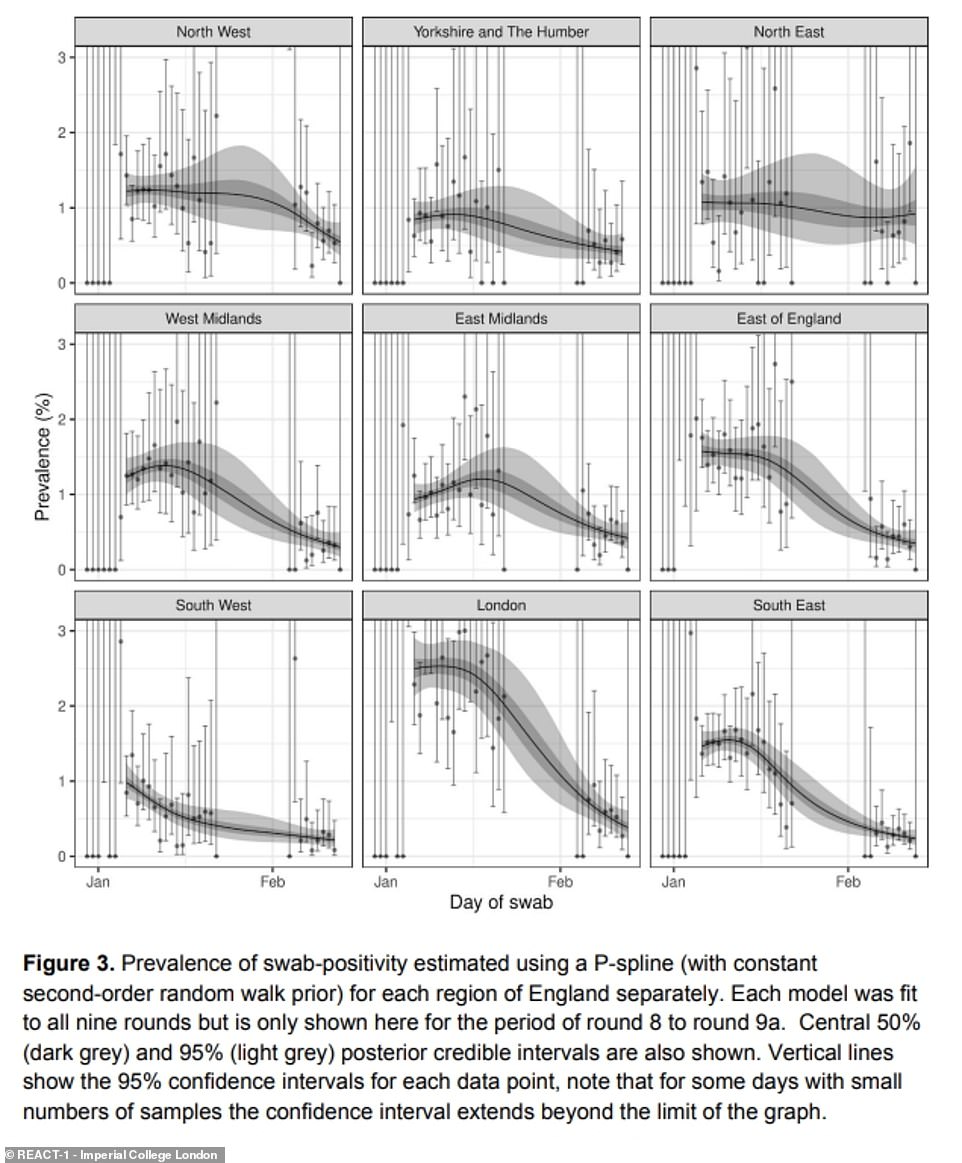
Prevalence of the virus had come down in all regions of England, the study found – most steeply in London and the South East – but the decline appears to have slowed in some parts of the country such as the South West and North East, where it may even be rising

The percentage of people testing positive in random spot checks has plummeted across England. The grey bar shows positive tests in January, the orange bar February

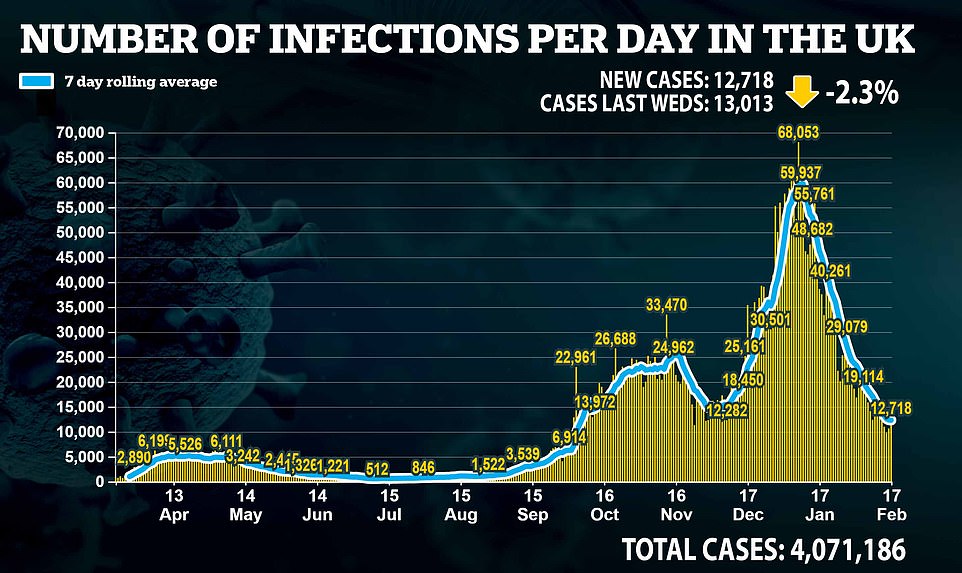
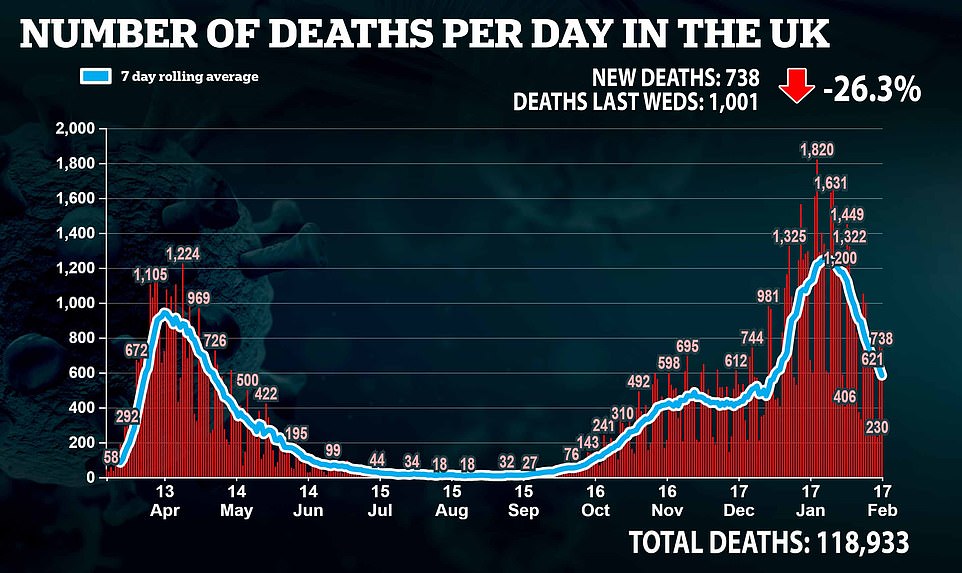
South African variant was in Britain in October, top scientist says
The South African variant of coronavirus was in Britain in October but was missed by scientists, a top Government expert says.
Addressing Parliament’s Science and Technology Committee, Professor Sir John Bell revealed that while the UK had been good at sequencing strains – it was not as good at identifying them.
‘In all honesty we did a lot of sequencing but we weren’t that great at identifying the variants when they were there,’ he said.
‘The South African variant had been fumbling around in the database since about October, November before we actually spotted it.’
Scientists are concerned by the variant because it contains the mutation E484K, which makes vaccines less effective. But studies show that those who get their jabs before they catch the variant are still protected from serious illness and death.
Mass testing has been carried out in several postcodes in response to cases of the variant, in an attempt to snuff them out before an outbreak takes off.
Advertisement
The study’s previous round of data, which covered January 6 to 22, estimated the R number to be 0.98 and one in 64 people to have been infected with the virus.
At the time scientists weren’t sure whether lockdown was going to work well against the Kent variant, which studies suggest is significantly more transmissible than older versions of the virus.
Professor Elliott said: ‘I think it is very reassuring that, despite the greater transmissibility of that variant, we are seeing this reduction.’
The team said the evidence suggested that the decline in infections was happening at a similar pace to the first lockdown in the spring of 2020, although its first data wasn’t collected until May, by which time cases had plummeted already.
Official NHS Test and Trace data shows cases are falling rapidly, too, with the number of people testing positive last week – 92,399 – down 28 per cent from 128,504 the week before, with even that week significantly lower than the 400,640 people who tested positive in the first week of January.
Hospital chiefs and SAGE scientists have warned the Prime Minister that there must be fewer than 1,000 coronavirus cases being diagnosed each day before the third national lockdown can be eased.
The REACT study found levels of infection are being halved every 14.6 days. If the rate continues, the UK can expect to reach 1,000 cases a day by the second week of April.
Which areas have seen the sharpest rise in Covid cases in the past week?
Department of Health data compares the change in the infection rate per 100,000 people from February 11, the latest date available, to a week earlier.
Area
Torridge
Exeter
East Ayrshire
Lincoln
Copeland
Powys
Newark, Sherwood
West Lindsey
East Devon
Perth, Kincross
% (infection rate)
+133.5% (44.3)
+89.1% (67.7)
+83.1% (283.6)
+36.3% (120.8)
+34.4% (240.5)
+28.1% (257.3)
+25% (115)
+24.1% (67)
+15.8% (72.4)
+15.5% (217.3)
Advertisement
Results also revealed prevalence has fallen in all nine regions of England with all areas except the north east having an R rate below one.
Coronavirus cases have also fallen throughout all age groups but are still highest in 18-24 and 5-12-year-olds according to the pre-print study, which has not yet been peer-reviewed.
Steven Riley, professor of infectious disease dynamics at Imperial College London said: ‘The two highest prevalence age groups are younger school aged children and young adults.
‘There are many different observations and data sets that now agree that probably schools being open does increase the R a little bit – we’re not sure exactly how much it does.
‘But my sense is…schools are the highest priority for reopening. I think there will be a very delicate trade-off.’
Professor Riley said their data shows no evidence of the impact of vaccinations yet, but they will ‘know more’ when further results come in later this month.
It comes as another scientist claimed the UK should ‘unlock earlier’ as long as the decisions were being ‘driven by data’.
Mark Woolhouse, a professor of infectious disease epidemiology at the University of Edinburgh, told a Science and Technology Committee yesterday that data is pointing to ‘earlier unlocking’.
‘I completely agree that we don’t want to be overly focused on dates, not at all,’ he said. ‘We want to be focused on data. But the point I’d make about that is the data are going really well.
‘The vaccination rollout is, I think, exceeding most people’s expectations, it’s going very well.
‘The transmission blocking potential is key.
‘But so, of course, is its actual ability to protect against death and disease, and to keep people out of hospital, and those numbers are looking really good.
‘My conclusion from that is: If you’re driven by the data and not by dates, right now, you should be looking at earlier unlocking.’
SYMPTOM-TRACKING APP CLAIMS CASES RISING IN SOME REGIONS, SCOTLAND AND NORTHERN IRELAND
The ZOE and King’s College app suggested yesterday that the number of people reporting symptoms of Covid has started rising again in Scotland and Northern Ireland, as well as Yorkshire, the North East and the East Midlands in England.
Scientists behind the surveillance study said infections are ‘starting to trend up again’ and called it a ‘hitch’, given that almost every other key metric shows that Britain’s second wave of infections is firmly in retreat.
Any turn in the trend could be devastating now, with the Government inching closer to finally lifting lockdown for good. But doctors and scientists say they want infection and hospital numbers as close to zero as possible before draconian restrictions end.
Figures collated by the King’s College London surveillance study show the biggest increase was seen in Scotland, where the daily number of symptomatic cases has risen to 28.5 per 100,000 people on February 13 — up from 25.2 the week before.
Infection rates have also risen in Yorkshire and the Humber (19.8 to 22.0), the North East (25.7 to 28.2), the East Midlands (22.0 to 23.8) and Northern Ireland (28.6 to 30.9). Covid outbreaks also appear to have stagnated in Wales, the West Midlands, the North West and the South East.
The Covid symptom-tracking study — which is the first surveillance project to flag that the outbreak has started to stagnate — estimates infections based on the number of people reporting symptoms linked to coronavirus and less so on actual positive tests.
Professor Tim Spector, an epidemiologist at King’s and lead scientist behind the study, said his team were ‘looking into’ whether the increase in symptoms was down to people having mild reactions to their jabs. He said another plausible theory was vaccinated people taking more risks, or an increase in close contacts as a result of millions of Brits travelling to vaccine centres to get their jabs.
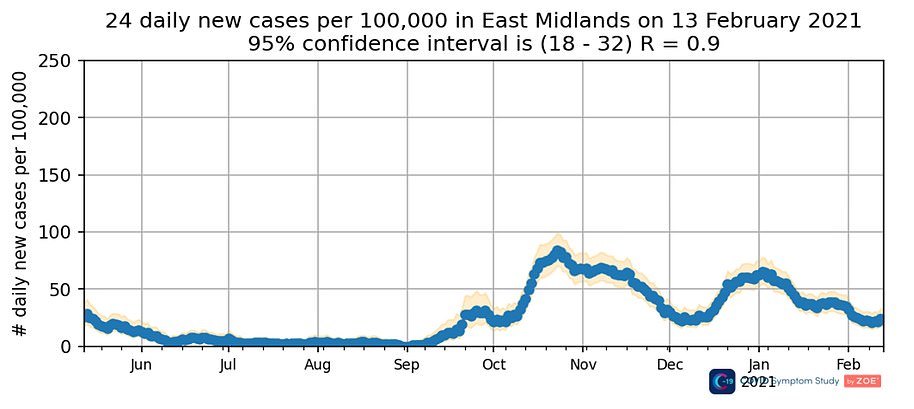

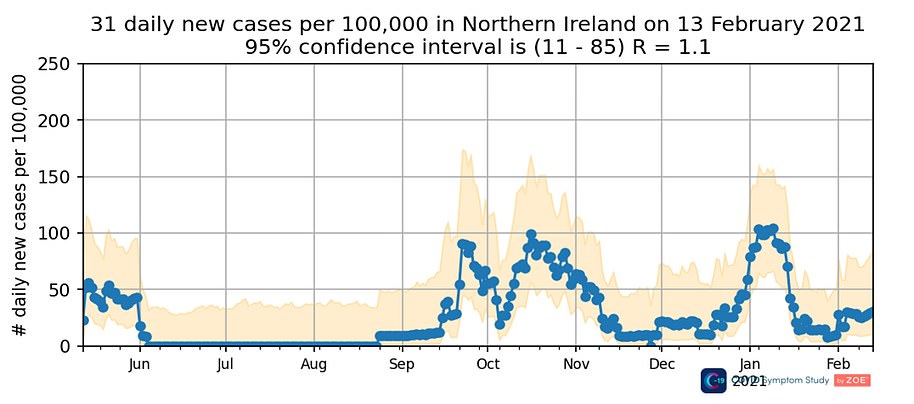
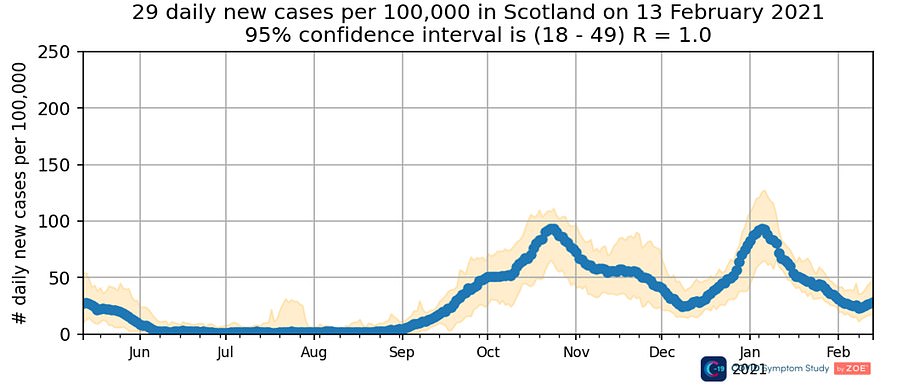
Advertisement
Source link : https://www.dailymail.co.uk/news/article-9271079/Coronavirus-infections-England-plummet-60-January-February-study-finds.html











